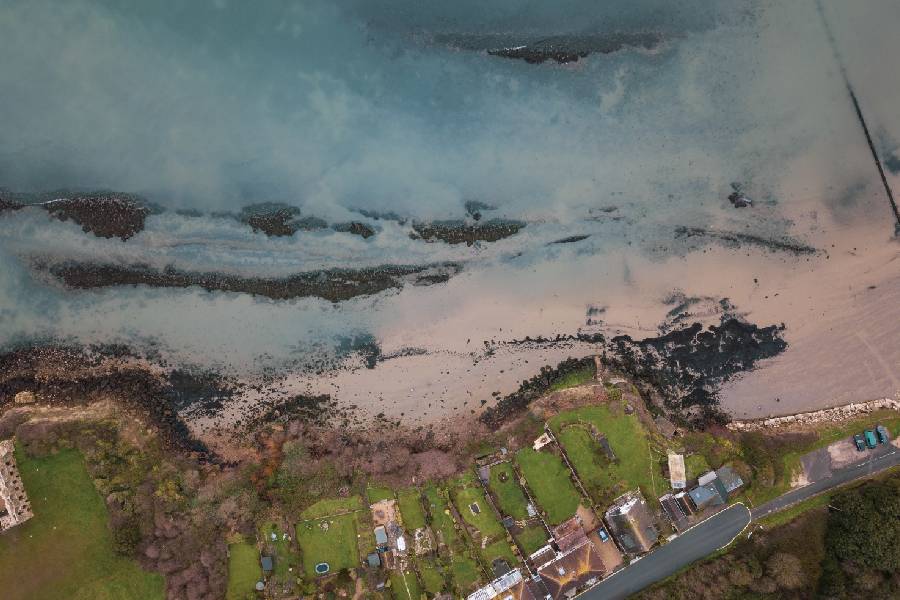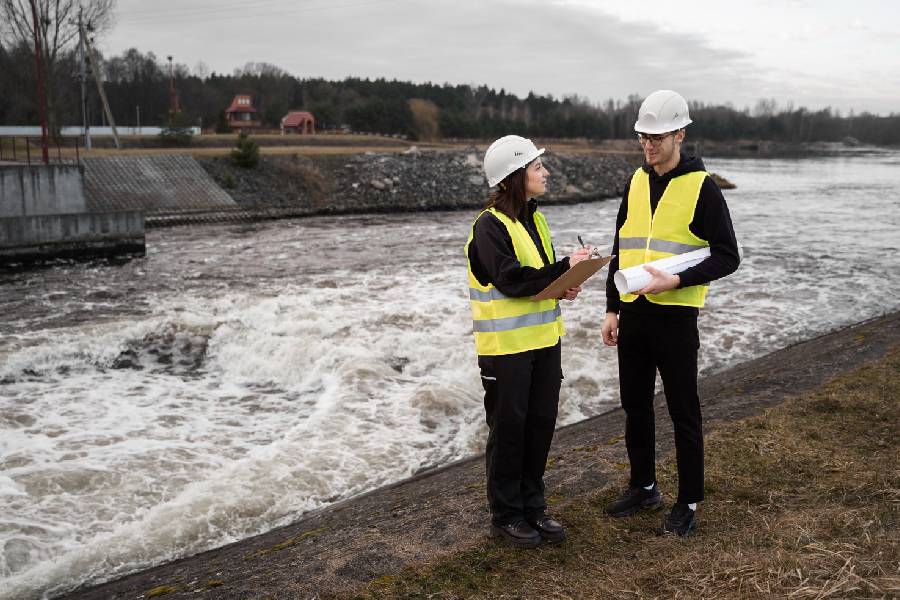Coastal engineering stands as a remarkable confluence of human ingenuity and the raw power of the sea. It’s a discipline that plays a pivotal role in protecting, shaping, and harmonizing the dynamic coastal regions that define our world. This article’s focus will be on what is coastal engineering exactly and why it is important.
In this exploration, we delve into the fundamental concepts and principles that underpin this fascinating field.
Coastal engineering is the art and science of managing the ever-changing coastal interface where land meets sea. It encompasses the design, construction, and maintenance of structures, systems, and strategies that safeguard coastal areas while promoting sustainable development.
It’s about balance – between the forces of nature and the needs of society, between protecting our natural habitats and fostering harmonious coexistence.

What Is Coastal Engineering?
Coastal engineering is a specialized field that focuses on managing coastal areas through the design, construction, and maintenance of structures, systems, and strategies. The goal of coastal engineering is to protect and sustainably develop coastlines.
At Cypress Environment & Infrastructure, coastal engineering is one of our core strengths. Our team analyzes waves, currents, and coastal processes. This helps us tailor sustainable solutions specific to each shoreline.
Whether tackling coastal erosion, planning for rising seas, or designing protective structures, we aim to safeguard coastal communities in harmony with fragile ecosystems.
Balancing the use and conservation of coasts is crucial. We reinforce shorelines from storms while restoring natural buffers like wetlands. Our innovative, localized solutions promote thriving, resilient coastlines.
The role of coastal engineers
As coastal engineers, our responsibility goes beyond construction. We act as the custodians of delicate coastal ecosystems, striving to protect biodiversity and foster harmonious coexistence between human society and natural habitats.
Our duty is to ensure the safety, habitability, and prosperity of coastal areas, making them resilient in the face of natural forces.
Coastal Hazards and Risks
The unpredictable nature of coastal hazards
From shoreline erosion to devastating storms, coastal regions contend with diverse hazards. Erosion steadily gnaws at beaches and bluffs, threatening structures. Storms generate intense waves and surges, causing flooding or complete inundation.
Meanwhile, rising sea levels continue reshaping entire shorelines and habitats. Seismic activity adds earthquakes and tsunamis to the mix. This complex combination of forces makes coasts dynamically perilous. At Cypress, we deeply understand these multifaceted hazards.
Real-world consequences
The consequences of coastal hazards manifest in very real ways, from homes damaged by storms to communities displaced by erosion. These threats pose clear urgency, as sea levels are projected to rise 1-8 feet globally by 2100.
Coastal hazards damage homes, displace communities and endanger lives. With sea levels projected to rise significantly in this century, mitigating risks is urgent. As coastal engineers, we provide solutions to ensure safety and continuity for coastal inhabitants.
Mitigating Coastal Erosion: Strategies and Safeguards
The perils of coastal erosion
Coastal erosion persists as a growing threat as rising seas accelerate land loss. The very existence of coastal properties, infrastructure, and communities hangs in the balance.
Erosion degrades beaches, undermines bluffs, and consumes wetlands over time through the constant barrage of waves and weather. As coastal engineers, we stand at the frontlines to confront this hazard and shield shorelines.
An arsenal to hold back the sea
To protect our coasts from erosion’s grasp, we employ an array of structural and non-structural methods. Seawalls, revetments, bulkheads, and other armoring structures form imposing barriers to diffuse wave energy.
Strategically placed groins and breakwaters intercept sediment drift to stem erosion. Beach nourishment and dune restoration rebuild eroded shorelines utilizing nature’s own assets. Managed retreat moves structures inland away from encroaching seas.
With our coastal engineering expertise, we can assess sites and tailor solutions to local needs, armoring coasts to endure the tests of time and tide.

Crafting Coastal Shields: The Science of Structures
The blueprint of coastal structures
Coastal structures are designed using advanced hydrodynamics and wave modeling. This reveals the forces structures must withstand. Key factors we analyze include wave heights, storm intensity, sea level rise, and material strength.
We select durable, corrosion-resistant materials able to endure repetitive loading, saltwater exposure, and ice impacts. Structural foundations must accommodate shifting sands and scour effects. Successful design hinges on effectively balancing strength, longevity, and environmental impact.
Purpose and function
We employ various coastal structures strategically to manage shorelines. Seawalls directly protect uplands from erosion. Groins build beaches by trapping sediment drift. Detached breakwaters reduce wave energy offshore to limit beach erosion. Each structure plays a unique role in controlling coastal processes.
Reviving Coastal Shores: Beach Restoration Expertise
Replenishing valuable beaches
Beach erosion poses threats to recreation, tourism, and shoreline communities. Nourishment projects rebuild eroded beaches by depositing sand dredged from offshore or inland sources. Sand is hydraulically pumped onshore and shaped into a widened beach profile.
Dune restoration further protects uplands by replanting vegetation. Repeated nourishment is often needed to combat ongoing erosion. Beach restoration provides valuable recreation space, habitat, and storm protection.
Beach nourishment techniques and benefits
We conduct beach nourishment to rebuild eroded shorelines, importing and depositing sand to widen beaches. Our team utilizes hydraulic dredges to pump sand onshore and then employs bulldozers to shape the beach’s contoured profile. We identify appropriate offshore and inland sand sources. Periodic renourishment accounts for ongoing erosion.
Our restored beaches provide valuable recreation areas for residents and tourists. They also create protective buffers, absorbing storm waves and reducing flooding. Habitat is created for wildlife like sea turtles and shorebirds. Beach replenishment brings significant economic benefits to communities.
Delivering effective beach nourishment
At Cypress, proper beach nourishment design evaluates native beach sand compatibility, local erosion rates, sea level rise impacts, and available funding. Pre-construction surveys map bathymetry and sediment. During implementation, quality control ensures specifications are met. Monitoring assesses project performance over time.
Coastal Modeling and Analysis
Forecasting the future
We employ advanced hydrodynamic, wave, and sediment transport models to reveal possible future coastal impacts under storms and sea level rise. Accurate lidar, bathymetric, and meteorological data improves model predictive capacity.
Model outputs like flooding extent, wave height, and beach erosion rates inform project designs and community planning. Sensitivity testing aids adaptation decisions. Reliable modeling provides critical foresight to proactively address coastal hazards.
Importance of high-quality data
Obtaining consistent, high-quality field data is crucial for coastal modeling. Long-term beach profiles, sediment samples, tide readings, and wave measurements improve calibration and validation.
Superior data enhances model accuracy, allowing us to develop engineering solutions with confidence. Real-world observations are essential to our mission of reliable coastal forecasting.
Leveraging modeling advancements
We stay current with ongoing advancements in coastal modeling and computing capabilities. New technologies like cloud computing allow running complex models faster. Improved satellite data provides higher-resolution topographic and bathymetric inputs.
Emerging AI techniques help refine model parameters. At Cypress, we continuously improve our sophisticated modeling by leveraging these latest innovations. Our goal is to provide clients and communities with the most scientifically advanced forecasting to plan coastal development for the future.
Adapting to Climate Change
Designing for sea level rise
As climate change accelerates, we integrate projections of rising seas into designs using the latest science-based predictions. Strategies include adding freeboard to structures, employing adaptive foundations, realigning infrastructure, and utilizing natural buffers like wetlands.
Managed relocation of at-risk buildings also adapts coastlines proactively. Our adaptive engineering employs predictive models, monitoring programs, and design revisions as seas rise.
Holistic resilience planning
We develop comprehensive resilience plans addressing amplified storm flooding, accelerated erosion, compromised drainage, and saltwater intrusion stemming from rising seas.
This involves coordinating policy, engineering, green infrastructure, and community education. Resilient coasts require integrated social, environmental, and infrastructure strategies enacted today to ready communities for tomorrow.

Conclusion
Coastal communities have a rich history of settling along shorelines, lured by the allure of access, abundant resources, and scenic beauty. However, they also grapple with inherent hazards that come with this proximity to the sea.
Coastal engineering emerges as the vanguard, utilizing the synergy of science and design to preserve these dynamic yet precarious coastal zones.
In the realm of coastal engineering, a delicate equilibrium is struck between the relentless forces of nature and the needs of human society. As the intensity of storms and sea-level rise escalates, coastal engineers emerge as the architects of resilience.
They fortify shorelines, meticulously model potential hazards, restore eroded beaches, and implement strategic plans for building a resilient future. So, what is coastal engineering? It’s the art and science of nurturing and sustaining our cherished coastlines.
As custodians of these ever-evolving coastal realms, we at Cypress Environment & Infrastructure, empower communities to not only withstand but thrive amidst the shifting tides. We forge adaptive strategies to ensure coasts remain both productive and enchanting for generations to come.
